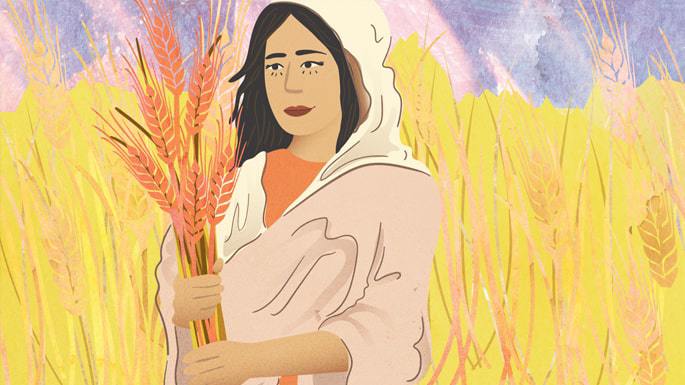|
Getting your Trinity Audio player ready...
|
By Menachem Posner(Chabad.org)
1. Ruth Is the Quintessential Convert to Judaism
Many female converts to Judaism choose the name Ruth, and for good reason! Ruth, whose story is told in the Book of Ruth, is celebrated as a sincere convert who embraced Judaism with all her heart, voluntarily leaving behind the comforts of her idolatrous background to follow the Torah and the G‑d of Israel.
2. She Was a Moabite Princess
Although not specified in scripture, tradition tells us that Ruth was a descendant of Eglon, king of Moab.1 She and her sister Orpah married the two sons of Elimelech, a wealthy Jewish man who had relocated from Bethlehem to Moab due to famine that was ravaging the Holy Land. In time, Elimelech died, and his sons died as well, leaving two young widows.
Read: Why Was This Intermarriage Kosher?
3. She Followed Her Mother-in-Law, Naomi
Ruth and Orphah were very attached to Naomi, whose name means “sweet.”2 Upon hearing that the famine had subsided in Bethlehem, Naomi decided to return to her people. Originally both daughters-in-law accompanied Naomi, but she entreated them to remain with their people, where they would be comfortable and cared for. Orpah turned back, but Ruth insisted on following.
Read: Ruth and Naomi
4. She Was Determined to Join Naomi’s People
At the end of a tearful conversation, Ruth famously told Naomi:
Wherever you go, I will go
And wherever you lodge, I will lodge
Your people shall be my people
And your G‑d my G‑d.
Where you die, I will die
And there I will be buried.3
According to the sages, she was not just pledging her fealty to the woman she loved and admired, but also accepting upon herself to keep the Torah, even the most difficult parts. This provided a template for Jewish courts to follow in the future, making sure that prospective converts are well aware of the challenges of Jewish observance.4
5. She Cared for Her Mother-in-Law
Wishing to support her mother-in-law, Ruth went out to the fields to gather isolated stalks and forgotten sheaves of grain that the harvesters were obligated to leave behind by Torah law.
Discover: The Mitzvah to Leave Grain
6. Her Modesty Attracted the Attention of Boaz
Boaz, leader of the Jewish nation and a relative of Naomi, noticed how she would sit down before picking grain, so as not to expose herself, and that she never would take bunches of three stalks, which by right belonged to the owner of the field (him) and not the poor (her).5 Impressed, he inquired about her and was told that she was the former daughter-in-law of Naomi.
Boaz generously invited her to pick grain in his field and to eat and drink along with his staff (who were instructed to be sure to leave grain for her to “discover”), which she continued to do until the harvest had finished.
Read: What Is Modesty?
7. There Were Technicalities Preventing Their Marriage
When it came time to winnow, Naomi instructed Ruth to surprise Boaz while he slept in the field, dressed in her finest and freshly bathed. When he awoke, she told him who she was and asked him to marry her and also buy a field that belonged to Naomi’s family. As a cousin of her late husband,6 it was his duty to both marry Ruth and “redeem” the properties.
Boaz readily agreed but told Ruth that there was another, closer relative, who would take first priority. Only after the other refused, could Boaz do so himself.
8. She Was the Ancestor of King David
Ruth and Boaz married and were blessed with a son, Oved, who Naomi—his doting grandmother—was very involved in raising. Oved was the father of Yishai and grandfather of the great King David.
9. Her Legacy Is Carried on By Jewish Women
The Book of Ruth could have just as easily been called the Book of Boaz. After all, he was the leader of the Jewish people at the time and a direct descendant of the royal clan of Judah. Yet it is known as the Book of Ruth. The Rebbe points out that this underlines the central place of the Jewish woman, who sets the tone for future generations and paves the way for the future Redemption, which will come about through a descendant of Ruth.7
10. We Read Her Story on Shavuot
Every year on Shavuot, the story of Ruth is read from the Book of Ruth. Some read it as part of Tikkun Leil Shavuot, the all-night learning session on the first night of the holiday, while others read it as part of Morning Services on the second day. Why Shavuot?
- Shavuot is the birthday and yahrtzeit (anniversary of passing) of King David, Ruth’s great-grandson.
- The scenes of harvesting in the book of Ruth are appropriate for Shavuot, which is the Festival of Harvest.
- Ruth was a sincere convert who embraced Judaism with all her heart. On Shavuot, all Jews were converts—having accepted the Torah and all of its precepts.





